Posted by James (admin) on 15th July 2013
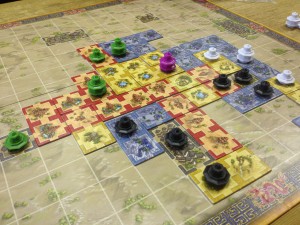
Note: The right-hand village should be owned by the white pagoda player as there are 3 white pagodas connected to it compared to 2 black pagodas.
Qin is a tile-laying game with a Chinese theme by Reiner Knizia. The winner is the first player to place all of their pagodas and players place pagodas on coloured territories they have created, so the game is about area control.
Players take turns placing 1 of the 3 tiles in their hand on the board next to any of the existing tiles. Each tile has 2 squares on it and each square can be red, yellow or blue. If a player creates a new contiguous territory of any single colour that consists of 2 squares or more, then they can claim that territory and place one of their pagodas on it. If a territory reaches 5 or more squares in size, then the owner adds a second pagoda to it.
If a tile joins two or more territories of the same colour together, then owner of the new large territory is the player who owned the most of the squares being combined. Territories of 5+ in size can never be merged.
Also on the board are some fixed black squares which are villages and these can be owned too. All the pagodas on territories that directly touch a village are added together – the player with the highest number places one of their pagodas on the village too. The pagoda on a village can change if the neighbouring territories change in a way to alter the totals and new clear winner emerges. Read the rest of this entry »
Tags: board game news, Board Games, board gaming, Knizia, Qin, Reiner Knizia
Posted in Board Game Review, Board Games, Essen Spiel 12, Qin | No Comments »
Posted by James (admin) on 12th September 2011
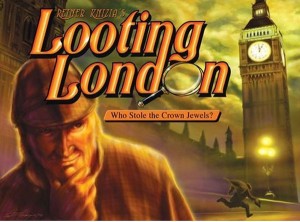 Looting London is a game that seems so simple you might think it doesn’t have much to offer as a game when the rules are explained; however, it contains a simple but clever little filler game. This is not too surprising when you know the game is designed by Renier Knizia and this game is quite typical of his designs.
Looting London is a game that seems so simple you might think it doesn’t have much to offer as a game when the rules are explained; however, it contains a simple but clever little filler game. This is not too surprising when you know the game is designed by Renier Knizia and this game is quite typical of his designs.
The players are investigating the theft of London’s 5 biggest treasures (although the theme is inconsequential in this game). The goal is to score as many victory points (VPs) which are scored by collecting tiles.
The game consists of various tiles and cards. Each tile is one of 5 colours (each matching a treasure) and has a number between 1 to 5 and a character (boy, detective, policeman and lady) on it.
The tiles are laid out randomly in a 5 x 5 grid. Each turn you can either take a card (one of 4 face-up cards, or one off the top of the deck unseen) or claim a tile that is at the bottom of a column. To claim a tile, you must discard a number of cards equal to the number on the tile AND the cards must show the character that is on the tile you’re claiming too. You can play any pair of matching cards to count as any character. Read the rest of this entry »
Tags: board game news, Board Games, board gaming, Knizia, Looting London
Posted in Board Game Review, Board Games, Looting London | 1 Comment »
Posted by James (admin) on 9th February 2011
Through The Ages is Reiner Knizia’s 1998 classic game of camel placement and area control. I haven’t actually played the original boardgame but have wanted to for some time, so the iPhone game was a great opportunity to do so.
THE GAME
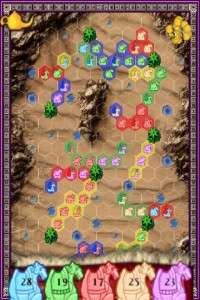 During the game, players place coloured camels (which come in 5 different colours) onto the board in order to score victory points (VPs). First, players place camels with their leaders on them (one of each camel colour), so long as they’re not too close to other leaders, water holes or oasis. Once all leaders have been placed, players take turns adding two camels (of any colours) at a time. Only one camel can be placed on each space and camels must be placed next to camels of the same colour so that coloured herds start to grow (herds of the same colour must not merge).
During the game, players place coloured camels (which come in 5 different colours) onto the board in order to score victory points (VPs). First, players place camels with their leaders on them (one of each camel colour), so long as they’re not too close to other leaders, water holes or oasis. Once all leaders have been placed, players take turns adding two camels (of any colours) at a time. Only one camel can be placed on each space and camels must be placed next to camels of the same colour so that coloured herds start to grow (herds of the same colour must not merge).
If a camel is placed on a water hole or next to an oasis, then the leader of that herd gets VPs. Players also get VPs for any areas that a herd cordons off. The game ends as soon as there are no more camels of any one colour. The biggest herd of each colour scores extra VPs for the herd’s owner. Read the rest of this entry »
Tags: board game news, Board Games, board gaming, iPhone, Knizia, Through The Desert
Posted in Board Games, iPhone, iPhone Review, Through The Desert | No Comments »
Posted by James (admin) on 8th February 2011
Battle Line is one of my favourite portable 2-player games. Consisting of a deck of cards and a few wooden pawns (and even the pawns aren’t totally necessary), it packs lots of punch by posing constant difficult choices and the potential for clever tactical game play.
THE GAME
 The basic game consists of 60 troop cards (values 1 to 10 in 6 different colours) and there are 9 flags laid out in a row between the players. On their turn, a player places one card next to any of the flags from their hand of 7 cards, then draws a new card. Each player can only place a total of 3 cards next to any one flag. When there are 3 cards on both sides of a flag, the player with the strongest set of 3 cards wins the flag and moves it to their side. The cards are compared similar to poker hands: a straight in a single colour is the best, then 3 cards of the same value, then 3 cards of the same colour, then a straight in any mix of colours and finally the total value of the 3 cards. A player wins the game as soon as they win 3 adjacent flags, or a total of 5 flags. Read the rest of this entry »
The basic game consists of 60 troop cards (values 1 to 10 in 6 different colours) and there are 9 flags laid out in a row between the players. On their turn, a player places one card next to any of the flags from their hand of 7 cards, then draws a new card. Each player can only place a total of 3 cards next to any one flag. When there are 3 cards on both sides of a flag, the player with the strongest set of 3 cards wins the flag and moves it to their side. The cards are compared similar to poker hands: a straight in a single colour is the best, then 3 cards of the same value, then 3 cards of the same colour, then a straight in any mix of colours and finally the total value of the 3 cards. A player wins the game as soon as they win 3 adjacent flags, or a total of 5 flags. Read the rest of this entry »
Tags: Battle Line, board game news, Board Games, board gaming, iPhone, Knizia
Posted in Battle Line, Board Games, iPhone, iPhone Review | 2 Comments »
Posted by James (admin) on 12th December 2010
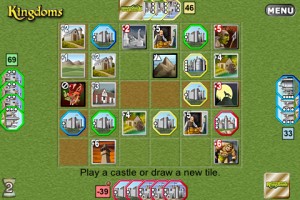 THE GAME
THE GAME
Kingdoms is a tile-placement game by Reiner Knizia which has some similarities to his game Robot Master. In Kingdoms, players place tiles and their own castles in order to sc0re victory points (VPs). The player with the most VPs after 3 rounds wins.
Next to the board, there’s a stack of land tiles too which each have values from -6 up to +6, as well as a few special tiles. Each player starts the game with a set of castle tiles (value 1 to 4) and 1 land tile.
Players take turns placing tiles onto a 6 x 5 grid and a player can either place one of their castle tiles or a land tile. When placing a land tile from the stack, players commit to drawing it before they see what it is. Read the rest of this entry »
Tags: board game news, Board Games, board gaming, iPhone, Kingdoms, Knizia
Posted in Board Games, iPhone, iPhone Review, Kingdoms | No Comments »
Posted by James (admin) on 16th November 2010
 THE GAME
THE GAME
Ra is one of Reiner Knizia’s classic games. In this case, it’s an Egyptian themed auction game. Players take turns either adding a random tile to those to be auctioned, or they can start an auction for the already drawn tiles. If a Ra tile is drawn an auction is automatically initiated. Three times during the game, the players score points (depending upon the type of tiles) for the tiles they have won, but the heart of the game is the clever, yet simple, bidding system.
During an auction, players get one opportunity each (going clockwise) to outbid any previous bid using one of their sun stones which each have unique values between 1 to 16. Players start the game with a pre-defined group of 3 sun stones (4 in a 2-player game) ensuring each player has a fair mixture, plus 1 sun stone is placed in the centre of the table. Read the rest of this entry »
Tags: board game news, Board Games, board gaming, iPhone, Knizia, Ra
Posted in Board Games, iPhone, iPhone Review, Priests of Ra, Ra | No Comments »
Posted by James (admin) on 8th October 2010
 Ingenious goes by several names (such as Genial and Mensa Connections). Ingenious is a good name for an English version as pulling out a game called Mensa makes most players wince at the idea and they have to be convinced to ignore the name and discover a really good game. Fortunately, I think it was only called Mensa in the UK.
Ingenious goes by several names (such as Genial and Mensa Connections). Ingenious is a good name for an English version as pulling out a game called Mensa makes most players wince at the idea and they have to be convinced to ignore the name and discover a really good game. Fortunately, I think it was only called Mensa in the UK.
THE GAME
Ingenious is an abstract game where players place tiles with coloured shapes on in order to score points. The tiles are made of two hexes and each hex shows one of 6 different colours (shapes). Players take turns placing one tile from their hand of 6 tiles.
When a tile is placed, both colours on the tile are scored – you score 1 point for each matching colour that can be traced in every direction from the tile in an unbroken line (neither of the colours on the tile itself count). It’s really simple and I’ll give an example using the screenshot on the right: A tile is placed in the right-most column just below the two red stars already present with a red star is at the top and yellow circle at the bottom. This would score 3 red points and 1 yellow point. If a player reaches 18 points in any one colour, they immediately take another turn. Read the rest of this entry »
Tags: board game news, Board Games, board gaming, Ingenious, iPhone, Knizia
Posted in Board Games, Ingenious, iPhone, iPhone Review | No Comments »
Posted by James (admin) on 24th September 2010
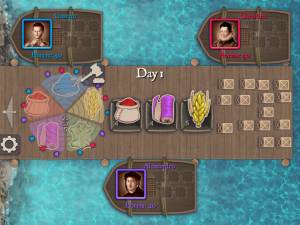 THE GAME
THE GAME
In Medici, players are merchants bidding over goods at the dockside so they can load their ships. There are 5 different types of goods and each good tile has a value from 0 to 5 on it too. On their turn, a player draws 1 to 3 goods one at a time and then auctions the good(s) off as a single lot with the current player bidding last. Players get just one chance to bid and can only ever buy a total of 5 goods in a round. If no-one bids on a lot they are thrown into the sea. A round ends when the goods run out or all players have their full 5 goods each.
At the end of a round, players potentially gain florins for their ships and their goods. Ship’s Score: Players each total the values written on their goods tiles – the player with the highest total number gains 30 florins and the next highest amounts gains florins too – the exact amount of florins and the positions that score are based on the number of players playing. Goods Sore: Each good tile (regardless of the value written on it) moves its owner’s marker one step along the relevant goods track (i.e. two cloth tiles would move the player’s marker 2 steps along the cloth track). Read the rest of this entry »
Tags: board game news, Board Games, board gaming, iPhone, Knizia, Medici
Posted in iPhone, iPhone Review, Medici | 1 Comment »
Posted by James (admin) on 8th September 2010
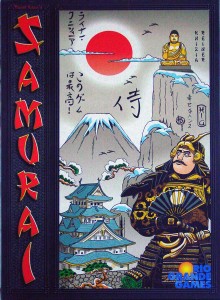 In Reiner Knizia’s classic game, players take turns placing hexagonal tiles from their hand onto a map of Japan where some of the hexes (villages, towns and cities) contain one or more of the 3 types of markers (helmets, rice fields, buddhas). When a location containing one or more markers is surrounded by tiles (sea areas don’t need to contain tiles), the tile strengths of each player are added up and the player with the greatest relevant strength wins the relevant marker. Many tiles’ strength only counts towards capturing one of the 3 types of markers but a few (like the Samurai) count towards all types.
In Reiner Knizia’s classic game, players take turns placing hexagonal tiles from their hand onto a map of Japan where some of the hexes (villages, towns and cities) contain one or more of the 3 types of markers (helmets, rice fields, buddhas). When a location containing one or more markers is surrounded by tiles (sea areas don’t need to contain tiles), the tile strengths of each player are added up and the player with the greatest relevant strength wins the relevant marker. Many tiles’ strength only counts towards capturing one of the 3 types of markers but a few (like the Samurai) count towards all types.
For example, a hex on the coast containing a Buddha maker has the following tiles around it: Red 2 buddha, Red 2 samurai, Yellow 4 helmet, Yellow 1 Samurai, Green 3 buddha. As the other hex around this location is a sea hex, the village is surrounded. In this case, Red wins the Buddha because they have a total of 4 towards capturing buddhas. Green’s total of 3 isn’t enough, and neither is Yellow’s total of 1 because their helmet tiles doesn’t count towards capturing buddhas.
Read the rest of this entry »
Tags: board game news, Board Games, board gaming, Knizia, Samurai
Posted in Board Game Review, Board Games, Samurai | 1 Comment »










